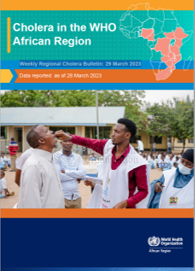
Cholera in the WHO African Region: Weekly Regional Cholera Bulletin: 29 March 2023
The cholera outbreak in the WHO African Region continues to evolve, with 13 countries currently affected. The concurrent climate-induced natural disasters such as cyclone and flooding in the southern African region and drought in the Horn of Africa threatens to impede the progress made in controlling the ongoing outbreaks. The cholera trends are being closely monitored as response and readiness measures are being ramped up.
In week 12, there was a modest increase of 17.4% in incidence cases, with 8807 cases recorded from nine countries compared with 7501 cases registered in week 11. This increase was mainly driven by an upsurge in cholera cases in Mozambique (while all the other countries observed reduction in new cases). On the other hand, there was a 51.5% decrease in deaths recorded during the same period, as 48 deaths occurred in week 12 compared with 99 in week 11 of 2023.
Cumulatively, 145 121 suspected cholera cases have been reported, including 3249 deaths (case fatality ratio (CFR = 2.2%)) as of 29 March 2023 (Table 1). Malawi accounts for 39% (56 090) of the total cases and 53% (1712) of all deaths reported, and together with Cameroon, Democratic Republic of the Congo, Mozambique, and Nigeria contribute to 97% (140 528) of the overall caseload and for 94% (3068) of cumulative deaths.
The cholera outbreaks in the African Region are happening in the context of natural disasters such as cyclones (Mozambique, Malawi), flooding (Mozambique, Malawi), drought (Kenya and Ethiopia), conflict (Cameroon, Democratic Republic of the Congo, Nigeria, Ethiopia) and multiple disease outbreaks including mpox, wild polio, measles, COVID-19 pandemic, etc. Many countries have limited and strained resources, shortage of medical commodities, including cholera kits and Oral Cholera Vaccine (OCV). Poor sanitation and unreliable water supplies with increased cross-border movements also serve as driving factors for the outbreak across the region.


